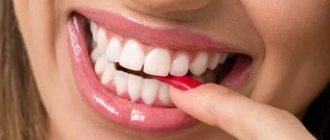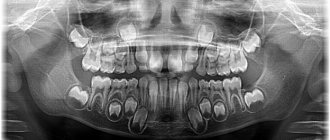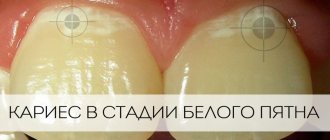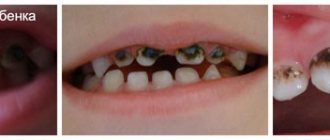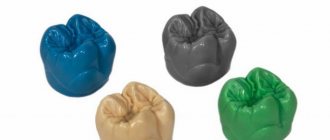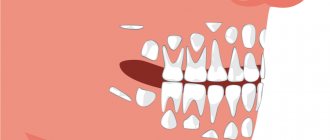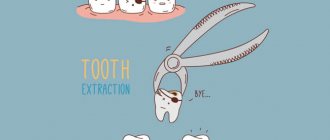- home
- Services
- Dental restoration for children
Baby teeth appear in a child from 6-9 months and are replaced by permanent teeth until the age of 12-14 years. Children's teeth, especially at an early age, are very vulnerable and susceptible to decay. It is careful attention to baby teeth that is the key to timely and correct growth of permanent dentition. A child with straight and beautiful teeth develops chewing and facial muscles correctly. Premature loss of even one baby tooth, untreated caries, crown injuries lead to the following problems:
- increased load on neighboring teeth;
- violation of growth order;
- deformations of the entire dentition;
- the occurrence of diction defects;
- deterioration of chewing function;
- aesthetic defects.
Changing the position of the rudiments of permanent teeth is a high risk of serious malocclusion, which is fraught with serious orthodontic treatment in the future. Natadent clinic specialists fight for every child’s tooth.
Why do you need dentures for baby teeth?
Prosthetics of primary teeth involves the restoration of damaged or extracted teeth in children using artificial materials. In this case, you can install either one denture or a bridge of several crowns. It used to be that only adults needed dentures. But relatively recently, doctors came to the conclusion that premature loss of baby teeth seriously impairs chewing function and negatively affects the child’s overall health. In addition, the absence of baby teeth significantly spoils the baby’s appearance and, as a result, undermines his self-confidence. Therefore, today parents, concerned about the mental and physical condition of their children, are increasingly turning to clinics for prosthetics of baby teeth, thereby ensuring the continuously growing popularity of this area in dentistry.
Advantages and disadvantages of dental extensions
In dentistry, various methods are used to restore lost tooth fragments, but for most patients, doctors recommend paying attention to tooth extensions. This is due to the numerous advantages of the procedure:
- A large selection of technologies and materials allows you to choose the optimal solution for each person and restore both front and back teeth.
- Highly aesthetic results.
- The restoration does not affect neighboring (healthy) units, does not increase the chewing load, that is, it protects the dentition from accelerated wear and destruction.
- Minimal trauma: oral tissues heal quickly without causing significant discomfort to the patient.
- The materials used during extensions are durable, aesthetically pleasing, do not change color and strength during use.
Dental extensions have virtually no disadvantages. The only drawback is the fairly high cost of services, but it can be adjusted by choosing simpler restoration methods and more affordable materials.
Indications for dental prosthetics in children
Only a pediatric dentist can give an accurate answer to the question of whether your child needs prosthetics for baby teeth. Typically, prosthetics of baby teeth in children is carried out if the following indications exist:
- Destruction of a baby tooth by caries and the impossibility of its restoration.
The absence of molars negatively affects the chewing of food, leads to stomach diseases and unwanted weight loss in children. The loss of frontal teeth can provoke the occurrence of speech defects or psychological complexes. - Tooth decay due to fluorosis.
This chronic disease develops even before teeth erupt, and subsequently causes stains on them and leads to their destruction. Dentures for baby teeth help prevent this process and preserve the aesthetics of a child’s smile. - The need for tooth extraction due to inflammation of the periosteum.
This disease often causes the appearance of neoplasms accompanied by pain. Often in such cases, the tooth must be removed. - Loosening or loss of teeth due to periodontitis.
This is a disease that affects the connective tissue between the bone of the tooth socket and the root cement. It can also lead to unwanted tooth loss in a child, and therefore is another indication for dentures for baby teeth. - Early loss of baby teeth.
Loss of a baby tooth a year or more before the appearance of a permanent one leads to shortening of the dentition in the permanent dentition in children, abnormal eruption of permanent teeth and significant disturbances in the dental system. - Tooth injury.
Children, due to their active lifestyle, are much more likely than adults to be injured. And the premature loss of even one baby tooth, as noted above, can lead to undesirable consequences for the child’s body. - Involuntary grinding of teeth (bruxism).
If not treated promptly, this disease can lead to deformation or premature loss of the tooth. - Edentia.
This is a complete or partial absence of teeth, which can be either congenital or caused by objective reasons.
There is a so-called 2x4 braces system
The idea is that the child is given braces on four permanent incisors (these are the front teeth) and two large molars. That is, it turns out that we can only use this system in children, starting from the age of seven or eight, when the incisors have already erupted.
What are the advantages of braces in young children when correcting their bite?
- The first advantage
is that with such a system (2x4) the effect occurs quite quickly, because it uses the mechanics and power of braces, which, in fact, move the teeth. - The second advantage
is that the braces are not removable, and therefore the child simply does not have the opportunity to take them off, say, during a visit to school, and put them back on. But this is also a minus of braces. About this - below
The global problem and disadvantage that lies in braces is that they are non-removable, which means that:
- firstly
, they contribute to the accumulation of plaque, and children do not always have the opportunity to brush their teeth properly, especially in school settings. This causes some discomfort. - secondly
, braces also impose restrictions on the intake of hard foods. That is, food must be crushed. Either chop it into pieces, or it should have a soft consistency. - and thirdly
, of course, this is what I already said, difficulties in oral hygiene, which means that the risk of developing caries, gum inflammation and everything that we consider as complications from improper oral hygiene increases.
If we consider all these devices in terms of the speed of occurrence and development of the effect, then, of course, the last technique - braces
- is the most effective. Again, I repeat, because it uses the power of the mechanics of the brace system.
Features of dental prosthetics in children
Children's dental prosthetics has its own nuances. Firstly, in adults the jaw is formed, while the child is growing all the time, and the dentist must do everything possible to ensure that the prosthetics of baby teeth does not disrupt the development processes in the body. Therefore, dentures for children must be hypoallergenic, safe, comfortable, and resistant to chemicals. Therefore, for the manufacture of children's dentures, materials such as acrylic, chrome-plated steel, stainless steel, silver and tin alloys are used. Secondly, children's structures should not interfere with jaw development.
According to their purpose, dentures for children are divided into the following groups:
- therapeutic – restore functions and correct the structure of teeth;
- preventive – prevent deformations and pathologies in the development of teeth and jaws;
- fixing – used for fastening orthodontic appliances and therapeutic materials.
Interesting fact!
Hippocrates called children's teeth milk teeth. He was convinced that the first set of human teeth developed from the milk that infants fed.
Why pediatric dentistry offers treatment rather than extraction
If the doctor sees that a tooth that should serve the child for another 4–7 years can be saved, he will definitely treat it. A prematurely removed baby tooth can cause problems with bite and pronunciation and lead to the appearance of very serious dental anomalies. So, if the baby “five” is removed before the permanent molar, the “six,” erupts, the child will have to be observed for a long time by an orthodontist and, most likely, wear a plate.
It is clear what the first experience of visiting a dentist will be like for a child who, at the request of his mother, will have a tooth removed. It is not difficult to assume that a frightened child will most likely become a difficult patient who cannot be lured into the dental clinic by any persuasion. He will certainly have serious dental problems in the future.
Types of dentures for children
Typically, children are fitted with fixed, removable or conditionally removable dentures. Removable (temporary) dentures are made according to individual jaw impressions, sometimes with additional elements (screws, springs, arches). In children's dental prosthetics, they are installed when several teeth are missing to widen the jaw or correct the position of the teeth, and they must be regularly replaced as the child grows. Fixed dentures are installed for long-term wear and are removed along with the falling out milk teeth.
Basic methods
There are several methods of teeth extension, differing in technology, compositions used, and price. The main methods include:
- Filling.
- Installation of veneers.
- Installation of crowns.
- Extension on a pin.
Each method has its advantages and disadvantages, which are discussed below.
Sealing
Filling is one of the simplest and most affordable ways to build up a tooth, provided that the bone tissue is preserved. The dentist selects a shade of the composite that is as close as possible to the patient’s natural enamel color. Then the composition is applied layer by layer to the dental unit, resulting in the formation of a monolithic structure with a tooth. The filling hardens under the influence of light - it quickly gains strength and practically does not wear out over time. The top layer is sanded and varnished, due to which it most accurately replicates the natural relief of dental tissue.
The main advantages of filling:
- Nerve preservation.
- Possibility of restoration of both minor defects and severe damage.
- High speed of the procedure - you can restore a tooth in one visit to the dentist.
The disadvantages include the fact that the aesthetics of the restored tooth directly depends on the skill of the dentist, who must give it the most natural shape possible. There is almost always a risk that the filling will look less natural than the “native” hard tissue of the unit.
Installation of veneers
Another way to build up your teeth is to install veneers. They are thin porcelain microprostheses that imitate the front surface of a tooth. Overlays allow you to hide discoloration, signs of enamel destruction, chips and make your smile attractive.
The service life of the plates is 10-15 years, during which they do not change color even with frequent consumption of coloring products (berries, wine, coffee). But dental porcelain can crack under high loads and direct impacts.
Before installing the veneer, the tooth is prepared - the top layer of enamel is removed. Then a plate is applied and fixed with dental cement. This extension technology is used to restore only the front teeth. Among the main advantages of the technique are:
- High aesthetics.
- Long service life of structures.
The disadvantages include the need to remove the top layer of enamel. This can be avoided by installing lumineers - even thinner microprostheses that are fixed directly to the tooth surface without preliminary preparation (grinding).
Installation of crowns
Crowns are metal, ceramic or metal-ceramic caps that imitate the surface of one or more dental units. Installing crowns allows you to compensate for serious defects - for example, chips or the complete absence of several teeth, and restore beauty and functionality to your dentition.
The denture is made in a dental laboratory using a previously taken impression, so it fits the patient perfectly. Before tooth augmentation, the oral cavity is sanitized, nerves are removed, and the units on which the crown will be placed are turned. The procedure requires multiple visits to the dentist.
Modern crowns made of ceramics and metal-ceramics restore aesthetics to the smile. The material imitates the shade of enamel, does not absorb food coloring, and does not wear out during use. The service life of crowns depends on the manufacturing technology and averages 10 years or more. The main advantages of this extension technique:
- Possibility of restoration of both anterior and chewing teeth.
- Restoration of dental units with partial or complete edentia.
- Highly aesthetic results.
Among the disadvantages is the fairly high cost of the procedure. However, the price can be reduced by using more affordable materials in the crown manufacturing process.
Extension on a pin
Extension on a pin or pinning is recommended by the dentist if the hard tissues of the tooth are destroyed, but the root is not damaged. During the procedure, a rod is screwed into the jaw, onto which a temporary crown is placed.
After the surrounding tissue has healed, the temporary crown is replaced with a permanent one. Advantages of this extension method:
- Possibility of restoration of both front and back teeth.
- A wide variety of post materials allows the patient to influence the cost of the restoration towards its reduction.
- Long implant lifespan.
The disadvantages usually include the need to restore tissue after implantation of the rod, during which a person experiences some discomfort (inflammation and swelling of the gums). Another disadvantage is the relatively high price of pin extensions.
Dentures for teeth
| Type of prosthesis | Material | Characteristics |
| Crowns | Stainless steel, metal alloys, acrylic (Strip crowns) Metal alloys | They are used for partial dental caries damage, trauma, and bruxism. The procedure for installing such prostheses is much faster and easier than conventional filling. In this case, the pulp is preserved, and the tooth is ground according to the method for “adult” prosthetics. During the installation of the crown, the doctor must carefully ensure that the crown does not extend beyond the edge of the gum. Fixed crowns can be placed on children aged 1 to 12 years, as they do not interfere with the natural process of baby teeth falling out. |
| Pins | Metal alloys | The design of the pin for children's dental prosthetics is similar to the design of the pin for adults. The children's pin differs only in a special element for more reliable fixation. As a rule, pins are installed in the roots of the front teeth in the upper jaw and canines in the lower jaw. According to the generally accepted method, the preparation of the supragingival part of the root for subsequent prosthetic restoration with a pin is carried out with carborundum stones. |
| Tabs | Metal alloys | Microprostheses, which are installed in place of missing tissues and recreate the anatomical shape of the tooth. In prosthetics, baby teeth are used to eliminate defects with the obligatory preservation of the dental pulp. |
| Bridges | Stainless steel, metal alloys | A structure consisting of several crowns that is attached to natural teeth. Restores chewing function and preserves the aesthetics of the smile. |
| Immediate dentures | Acrylic, nylon | The most popular type of partial dentures. Used to replace one lost tooth. Almost invisible. It takes some getting used to. It is characterized by the absence of contraindications and is suitable for all patients without exception. |
| Clasp dentures | Nylon | Comfortable, ensure even distribution of load between all teeth. They exactly follow the contours of the gums and are therefore quite complex to manufacture and require several visits to the dentist. Elastic and flexible, they are fixed to adjacent teeth with soft nylon clasps. It takes some getting used to. They do not rub the gums and are almost invisible due to their transparency. |
| Complete overdentures | Acrylic, nylon | Completely replace all teeth on one or both jaws. They are attached to the palate by suction or using a special cream. They are durable and do not require special care. |
How to choose a clinic for prosthetics of baby teeth?
When choosing a clinic for prosthetics of baby teeth, it is necessary to study information about the institutions performing this procedure, and, in particular, find out whether they have licenses to provide dental services to children. There are few such clinics, but you should still be puzzled by finding exactly the dentistry where your child will be provided with professional assistance in prosthetics of baby teeth by specialists with appropriate qualifications.
How to care for children's dentures?
Children should care for dentures in the same way as natural teeth. You should brush your teeth twice a day and after every meal. If there are no necessary conditions for this, rinsing with clean water and using dental floss is acceptable. In some cases, depending on the material of the dentures, it is necessary to carry out regular professional cleaning of the dentures in the dental office.
Alternatives to implantation
If teenagers have problems with their teeth, this does not mean that it is impossible to help such patients in any way and they will have to walk with a defect for several years. As the methods of caries treatment , so do the techniques of restorative dentistry. In modern conditions, it is possible to replace a lost tooth with a temporary removable denture for long-term wear. It will help close the defect and wait until the time when implantation can be done. At what age can you get dental implants? You can consult a doctor who will take pictures of the bone and conduct additional studies to assess the maturity of the bone tissue. After a positive answer from the dentist, you can safely begin the procedure.
Contact
Prevention of dental prosthetics in children
Premature loss of baby teeth, and therefore dental prosthetics in children, can be avoided if you promptly and regularly visit a dentist who diagnoses the condition of the teeth, identifies possible bite defects and diseases of the oral cavity. Proper dental care and attendance at preventive examinations will eliminate the problem at the initial stage, avoid tooth loss and the need for prosthetics. The child’s nutrition also plays an important role in the preservation of baby teeth. After all, if there is a lack of substances necessary for a growing body, teeth are destroyed on their own, without mechanical impact on them. Currently, with busy parents and unfavorable environmental and economic factors, the condition of children’s teeth is worsening every day and prosthetics of baby teeth is becoming increasingly important. Therefore, preventive measures should be taken to maintain dental health from an early age.
Prices for dental prosthetics for children
The cost of prosthetics for primary teeth depends on the category of the clinic, the qualifications of the specialist, the amount of work of the dental technician and the material from which the prosthesis will be made. Moreover, the initial consultation with a pediatric dentist in most clinics is free.
| Type of prosthesis | Price |
| Removable denture made of acrylic | from 12,000 rubles |
| Bridge prosthesis | from 25,000 rubles |
| Clasp denture | from 30,000 rubles |
| Quadrotti removable denture without palate | about 32,000 rubles |
Which is better - filling or crown?
Each method has its advantages. The choice regarding a crown or tooth extension in each clinical situation depends on the degree of destruction, the condition of the root system and periodontal tissues.
For small defects, it is advisable to use composite extensions. If a part of the tooth breaks off or is completely destroyed, it would be better to install a crown. Restoration with filling material is more financially profitable, but to make the final decision - to install a crown or build up a tooth, the indications are taken into account.
